Address to the Australian Business Economists, Sydney, 16 May 2006.
Ken Henry1
In the background of Australia’s current benign economic environment are three powerful and long-lasting forces: the information technology revolution, population ageing and the economic emergence of China and India. China’s re-emergence has driven up commodity prices and raised Australia’s terms-of-trade. This has important implications for the Budget projections and for the economy more broadly.
Economic theory suggests that a rise in the terms-of-trade will be associated with a shift of capital and labour from Australia’s manufactures sector to the resources sector. This may be associated with a fall in real wages. Depending on the extent to which the higher terms-of-trade are anticipated, and the response of the exchange rate, there could be a temporary increase in the current account deficit.
The rise in the terms-of-trade has had different impacts across industries and regions. But it would be undesirable to try to resist this with industry policy or by raising tariffs.
Introduction
If Australia’s recent macroeconomic performance is any guide, the economic environment is remarkably benign. The macro economy is growing at around its potential growth rate of 3 to 3 per cent; underlying inflation is around 2 per cent; the unemployment rate is at 30-year lows of around 5 per cent — low also by international standards; wages growth, at about 4 per cent, is not putting pressure on average unit labour costs; and the government has no net debt. The world economy is also doing well, having grown above trend for 3 years. While, as always, we can identify short-term risks to the outlook, our forecasts would have these domestic and global pictures continuing.
Yet, despite this apparent macroeconomic stability, there are forces acting on the Australian and global economies that are both powerful and long lasting. Global macroeconomic performance is playing out against, and is being very heavily affected by, three historic medium- to long-term developments: (1) the ICT ‘revolution’; (2) the economic emergence of China and India; and (3) population ageing. Just how each of these developments affects the macroeconomic performance of the international economy, and of its national member economies, depends upon many things. An important one is the ebb and flow of the contest between the internationalising forces of globalisation and the efforts of nationalist protectionists. But it is important to recognise too that this contest is itself being influenced strongly by the ICT revolution, the emergence of China and India, and population ageing.
The ICT revolution is creating an information and communications superhighway that ignores national borders. China’s re-emergence as a major player in world merchandise trade and the impending emergence of India and others is bringing hundreds of millions of people into the modern world.2 And the uneven global pattern of population ageing will have far-reaching implications for capital markets and, quite possibly also, for migration flows, forcing national policy makers to confront issues as fundamental as national identity.
The fact that these forces are powerful and long lasting does not mean that they will always play out smoothly. There will be episodes of volatility, some of which will pose difficult challenges for policy makers.
The ICT revolution provides a recent example. It underpinned an enormously positive sentiment toward the United States economy in the second half of the 1990s; a sentiment captured initially by the rather startling term ‘irrational exuberance’. Later, and when policy makers and commentators found it imperative to find rationality in exuberance, by the even more startling label the ‘new economy’ — a startling label because it was being used to describe the most developed economy on earth.
That positive sentiment under-wrote a US stock market bubble funded by an unprecedented inflow of portfolio equity capital apparently disinterested in traditional notions of reward. It provided financial substantiation of persistent US Treasury rhetoric supportive of a ‘strong’ US currency. And it financed a burgeoning US current account deficit. And when, inevitably, the bubble burst, even rational bystanders suffered substantial real and financial losses in the global downturn of 2001.
China’s re-emergence may also be accompanied by periods of volatility. There is risk in the fact that it is provoking industrial country protectionists who want to rebuild and buttress the fortresses erected in the middle decades of the last century. Were they to be successful, the consequences for world economic performance could be very serious.
Industrial country protectionists are concerned by China’s impact on the world prices of manufactures. But even more pronounced has been China’s impact on the price of energy and of commodities in general. Commodity price developments are affecting all economies. For some, like our own, the immediate consequence is extraordinarily high terms-of-trade. Other economies are having their terms-of-trade hammered. High terms-of-trade should be good news. But it is the sort of good news that has policy makers sitting on the edge of their seats. And for good reason: earlier terms-of-trade booms have not always been comfortable times for Australian policy makers.
China’s re-emergence
Today I want to explore some of the implications for the Australian economy, and Australian economic policy, of the re-emergence of China.
In the period since the Second World War there have been several instances of rapid industrialisation in various parts of the world: Japan from 1955; the NIEs3 from 1967 and the ASEAN-44 from 1973. But, thus far at least, China’s development since 1979 eclipses all of these.
Chart 1: Growth after takeoff
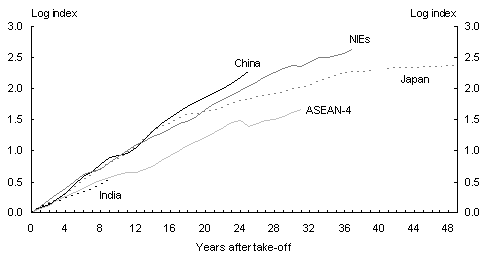
25 years ago, China accounted for less than 1 per cent of global merchandise trade. Today, it accounts for more than 6 per cent — about a percentage point higher than Japan’s present share and only about 1 percentage points less than Japan’s high point.
Chart 2: Share of world merchandise trade after take-off
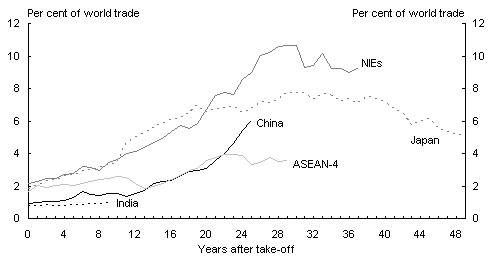
This extraordinary trade performance has been fuelled by massive quantities of material inputs: nickel, aluminium, copper, zinc, steel, iron ore and coal. In respect of the last two, China now absorbs more than a third of global production.
Chart 3: China’s share of world consumption of materials
2005
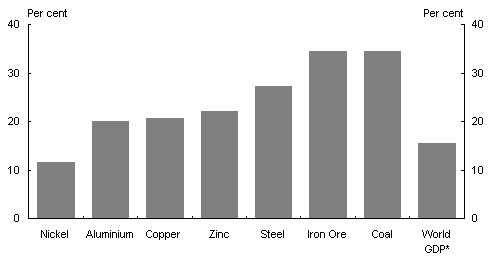
Note: *China’s share of World GDP
An immediate consequence of this substantial addition to the global demand for industrial material inputs has been a dramatic rise in commodity prices, especially for coal and iron ore. Average prices received by Australian non-rural commodity exporters have increased by over 60 per cent in the last two years.
Chart 4: Commodity prices
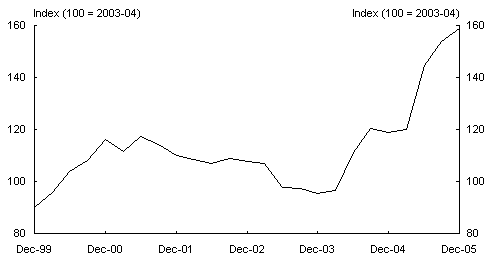
While China’s industrialisation has added substantially to the global demand for material inputs, it has, as Chart 2 illustrated, also been adding substantially to the global supply of manufactures. Australia is a net exporter of many of the materials used in Chinese industry and a net importer of manufactures. Of course, only about one third of our exports have benefited from the higher prices illustrated in Chart4, and many of the things we import have not been affected by Chinese supply. Even so, when we look at what has happened to the ratio of average export prices to average import prices we find a very significant pick-up in our terms-of-trade.
Chart 5: Terms-of-trade
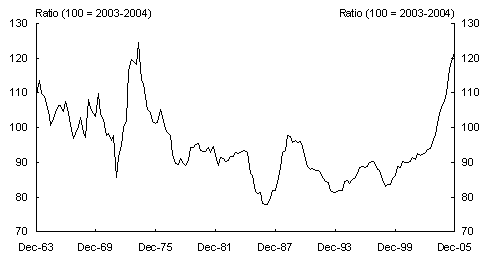
Implications for Budget projections
Chart 5 goes back to 1963. It shows that present conditions are quite unusual. It also shows that terms-of-trade booms can be short-lived. There is substantial interest in knowing for just how long the present high commodity prices and terms-of-trade surge might last. Investors and resources producers have an obvious commercial interest in the matter. One of the Treasury’s interests is in understanding how the terms-of-trade boom might be affecting the budget — more generally, what is the likely impact of the terms-of-trade boom on present and prospective budgets and how is it affecting the stance of fiscal policy? These are difficult questions.
In order to make fiscal projections, we need projections for key macroeconomic variables. Forecasting is difficult, and increasingly so the longer the time horizon. For this reason, rather than make long-term forecasts, our standard approach is to base our projections on an economy evolving as it has on average in history. Another reason we take this approach to projections is that several of the variables we project are commercially significant, and we would prefer not to be criticised for any losses that people like you might make in reliance on our judgements.
A third reason supporting our approach is that we want to avoid any risk of confusion about the respective macroeconomic policy responsibilities of the Treasurer and the Reserve Bank Board. There is a risk that if we were to publish a judgement about the future direction of, say, the exchange rate or interest rates, we might be interpreted as taking a view on what these things should be as opposed to what we think they might be. Better, we think, simply not to be seen to be taking a view at all.
Incidentally, the projections of interest rates, exchange rates and so on are used also in deriving our forecasts for real economic activity — a point that seems easily lost in public commentary.
You will recall that when we put together the macroeconomic projections to support last year’s budget, we thought it would not be prudent to assume that recent commodity prices would be sustained over the three-year projection period. Instead, we adopted a prudent assumption that coal and iron ore prices would decline in two annual steps back to historical levels. When we updated the Budget outlook at MYEFO, we began forecasting rather than projecting activity in 2006-07. However, our approach to the projections still seemed a prudent one to us. Thus, we moved everything out a year, with the first downward step in coal and iron ore prices occurring in 2007-08 and the second in 2008-09. We have confirmed this approach in the 2006-07 Budget.
Chart 6: Commodity prices (with forecasts/projections)
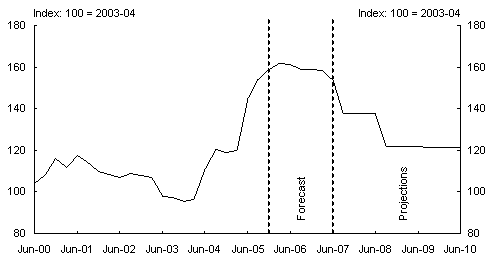
Average commodity prices are projected to fall by about 25 per cent, remaining 10percent or so above year 2000 levels. So, in our fiscal projections, we have taken out quite a lot of insurance against a commodities price collapse. Pessimistic commentators consider that even that level of insurance is not sufficient to protect the budget against a major ‘China stumble’. Well, there are lots of possible adverse developments that are at present ‘unforeseen’, and which would have a material impact on fiscal outcomes. The possibility of China’s stumbling is among them, but there are many others. Our fiscal position provides us with a great deal of flexibility to respond to such unforeseen developments. I would go further: if the adverse shock were so large that it drove the budget into deficit, then a deficit budget outcome would be appropriate. Moreover, such an outcome would be quite consistent with the fiscal strategy.
The optimists, on the other hand, are asking whether, if commodity prices stay up at around present levels for many years, we won’t turn out to have been too conservative in our fiscal projections. And at what point, they want to know, would we decide to accept reality and abandon the downward bias in our projections? As to the first question, the answer is, ‘other things equal, yes’. All I can say about the second question is that our macroeconomic projections will continue to be driven by history. If the emerging history gives us sufficient confidence that the present projections methodology is too conservative, then we will adjust it. We are not at that point yet, however. It is our view that, for the moment, it is prudent to base the fiscal projections on the step-down in commodity prices illustrated in Chart 6.
It’s worth noting that our downward adjustments to coal and iron ore prices have much less of an impact on the projected terms-of-trade than they do on projected commodity prices. The terms-of-trade remain well above average levels, and only about 10 per cent below where they are right now. And it is the terms-of-trade that are of importance to the pattern of resource allocation in the Australian economy.
The present high terms-of-trade might turn out to be short-lived. Yet, in thinking about the implications for the Australian economy of the re-emergence of China, India and others, it would not be prudent to ignore the possibility that the terms-of-trade remain well above historical levels for a considerable period of time.
Chart 7: Terms-of-trade (with forecasts/projections)
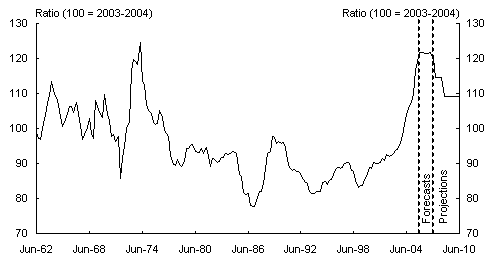
Implications for the economy
As many analysts and commentators have pointed out, the present terms-of-trade boom has a very different genesis from the 1970s spike.5 That earlier episode was both sharp and largely confined to rural commodity prices. Following an initial terms-of-trade spike, a further shock was introduced into the global economy by an artificial oil supply shock engineered by the OPEC cartel. Economic theory, and a good deal of economic history, tells us that cartels have a difficult time sustaining such behaviour. We should expect such episodes to be short-lived, as that one was, even if the cartel itself endures. The present commodity price boom, by contrast, is largely demand driven and reflected in a wide set of non-rural commodities. Provided resources production is not subject to long-run increasing returns to scale (declining long-run average costs of production), prices should remain above historical average levels for as long as demand remains above where it would have been on the basis of trend growth. That is not to say that there will not be volatility sufficient to produce temporary falls in commodity prices. And nor does it imply that commodity prices will stay up at present levels: we should expect prices to fall somewhat as new supply capacity
is brought on stream. But, absent a substantial and sustained negative shock to global demand, we should not expect to see average commodity prices fall all the way back to turn of the century levels.
And as far as the denominator of the terms-of-trade is concerned, continued expansion in Chinese manufacturing could put downward pressure on our average import prices for many years.
So it is worth exploring what might happen to the Australian economy if it turns out to be the case that the terms-of-trade are permanently higher, even if not quite as high as at present.
Standard economic theory offers numerous insights on the economic effects of an improvement in the terms-of-trade. In this standard theory, the factors of production (capital and labour) are perfectly mobile between industries, moving in response to factor returns (wages and the return on capital). So there are no rigidities associated with labour and capital being tied to specific sectors. However, the total (i.e., economy-wide) supply of labour and capital is fixed. In these models, one sector of the economy produces ‘exportables’ and another is ‘import-competing’. The former produces things that are both exported and consumed domestically, while the latter produces things that are only consumed domestically and which compete with imports.
Chart 8: Australia’s net exports
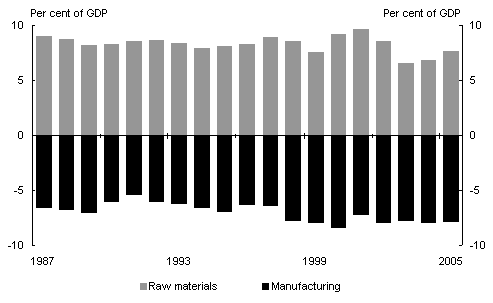
Many of the goods and services that we export, including a lot of manufactures and services, are not enjoying higher prices as the terms-of-trade increase. The exportables industry that is the clearest beneficiary of higher prices is resources. Import-competing activities facing static or declining prices are numerous. Import-competing manufacturing has gained the most attention, but its circumstance is broadly shared. Nevertheless, to keep the following discussion as simple as possible, I am going to label the exportables sector ‘resources’ — noting that this sector is relatively capital-intensive — and label the import competing sector ‘manufactures’. With this gross simplification, the terms-of-trade is the price of resources relative to the price of manufactures.
According to standard economic theory, and ignoring everything else that is driving economic activity, we might expect the consequences of a permanent improvement in the terms-of-trade eventually to include the following:6
- Output of the resources sector increases and output of the manufacturing sector falls.
- The set of domestic consumption possibilities expands. Consumers are better off, enjoying higher real income in aggregate. They demand more manufactures, though the impact on the domestic consumption of resources is ambiguous.
- The volume of trade expands: volumes of both manufactured imports and resources exports increase.
- The resources sector employs a higher proportion of the economy’s capital and labour.
- The real wage rate falls, no matter which output price, or combination of output prices, is used to ‘deflate’ nominal wages.7 Consistently, labour’s marginal and average products fall in both industries.
- Capital productivity rises, and so too does the real return per unit of capital.
- Labour’s share in GDP falls and the profit share increases.
From these standard results, several corollaries of distributional interest follow: the reallocation of the factors of production may be reflected in an internal geographic migration of capital and labour; property owners in resource-rich parts of the country derive capital gains, while those in the non resource-rich parts of the economy may experience capital losses, as may many who own sector-specific capital in the manufacturing sector; earnings per share increase; domestic and foreign shareholders in Australian companies benefit from higher dividends and from the higher wealth that comes with consequent share price growth; and company tax revenue increases, both in absolute terms and as a proportion of total income tax revenue.
The reduction in real wages is a standard Stolper-Samuelson result. Even so, it might strike some of you as a bit odd. An intuitive explanation is as follows: Starting from a position in which labour and capital are fully employed, the output of the more capital-intensive sector expands, and the output of the other sector contracts. Suppose this were to happen with no change in the capital intensity of production in either sector. Then the expanding sector would be requiring additional factor inputs in a higher proportion of capital to labour than they would be released from the contracting sector. The only way this can happen is if labour becomes unemployed; that is, if some of the labour released from the labour-intensive sector is not re-employed in the expanding capital-intensive sector. A real wage reduction ensures that labour remains fully employed. It achieves this by encouraging both sectors to reduce their capital intensity of production.
The effects described above are comparative static impacts. They don’t tell us anything about the time path of adjustment, nor adjustment costs. And they deliberately ignore the effects of exogenous shocks other than an increase in the terms-of-trade. These are important qualifications. For example, while the theory says that higher terms-of-trade will be associated with lower real wages, that does not amount to a forecast that real wages in Australia will fall. For one thing, the reallocation of capital in favour of the resources sector will stimulate construction activity, including residential construction, in the resource-rich parts of the country, and that will be reflected in strong employment growth, possibly even labour shortages, exerting some short-term upward pressure on real wages. For another thing, although this upward pressure should be only temporary, the longer term trend of real wages will be driven by the rate of multi-factor productivity growth; and this may very well be more than enough to compensate for any downward pressure associated with the higher terms-of-trade.
Another example of thinking about adjustment paths reveals an important additional result from economic theory: the reallocation of labour and capital in favour of the resources sector will take time. So there could be a lag, possibly lasting several years, before outputs of the resources sector, and export volumes, increase. But consumption and investment may well respond immediately to higher anticipated real national income. In this case:
- There could be a temporary increase in the current account deficit, with national investment outpacing national saving. While import volumes might increase immediately, export volumes may even fall in the short term.
Judging by the weight of commentary on this topic, the conclusion that a terms-of-trade improvement could imply no growth, or even a reduction, in export volumes, possibly lasting several years, will strike many as counter-intuitive. It shouldn’t.
So far, I haven’t mentioned the nominal exchange rate. That’s because none of the impacts to which I have referred rely on there being any movement in the nominal exchange rate. This is a rather important point. Many Australian manufacturers would be thinking that the reason they are feeling the squeeze from our higher terms-of-trade is that the exchange rate has appreciated. But even if the exchange rate were not to appreciate, they would eventually feel the squeeze because they would find it increasingly difficult over time to compete with the construction and resources sectors for the economy’s factors of production.
These are, of course, long r
un results. As I explained in some detail in last year’s address, an appreciating exchange rate contributes to macroeconomic stability during the shorter-run adjustment period. Cushioning the domestic economy from the real affects of external shocks is the principal economic role played by a floating exchange rate.
While a higher terms-of-trade might imply a higher current account deficit in the short-term, what happens to the current account deficit in the longer term depends upon what happens, over time, to the gap between national investment and national saving. A higher terms-of-trade should be associated, eventually, with higher levels of both saving and investment, with the impact on the gap between the two being ambiguous. There is, however, an unambiguous change in the composition of the current account deficit: The increase in the real return on capital attracts capital inflow, expanding the economy’s total supply of that factor. Provided the terms-of-trade are not adversely affected by this international transfer of capital, the real return on capital will be unaffected.8 But there will then be a higher stream of remittances to the foreign owners of capital — a permanently higher net income deficit on the current account.
It might be tempting to think that the addition to the nation’s capital stock will allow the output of the resources sector to expand without there necessarily being a contraction in the manufacturing sector, and that it will provide economy-wide capital deepening so that real wages need not fall. But that is not what the standard theory says. Rather:
- If the capital stock increases in response to the higher real return on capital, not only will output of the relatively capital-intensive resources sector increase by even more, but the output of the labour-intensive manufacturing sector will fall even further.9 And the aggregate capital-deepening will not be reflected in higher real wages.10
But what if the eventual increase in export volumes is sufficiently large as to have an adverse impact on the terms-of-trade? Then there will be some amelioration of the trends in factor allocations, sectoral outputs and real factor rewards. Provided international capital markets do not overshoot, the impact on the terms-of-trade cannot be large enough to completely reverse these trends. Actually, that is a tautology. However, as we know, markets often overshoot, and so a more than complete reversal of the initial terms-of-trade improvement cannot be ruled out.
Implications for industries and regions
While these various results are derived from a highly simplified two-sector, two-factor, long run theoretical model, they nevertheless provide several insights important to an understanding of the changes presently occurring in the Australian economy. Currently, there is quite a bit of interest in what appears to be happening to the composition of Australian output and employment. The model tells us that if the terms-of-trade remain at high levels, not only will the resources sector command more capital and labour, manufacturing and other industries whose relative output prices are declining will command less, even as our total stock of capital expands. Furthermore, as the factors of production are reallocated, the pattern of growth will be characteristic of what is often referred to as a ‘two speed economy’.
The fact that our higher terms-of-trade are a challenge for Australia’s manufacturers hasn’t gone unnoticed. Recently, the Australian Industry Group11 drew attention to a loss of employment in the manufacturing sector. Some of this loss of manufacturing employment would be associated with the housing cycle — Australia’s manufacturing being relatively closely related to residential construction; and, in most of the country, housing construction has been weak for about two years. But some of this loss of manufacturing jobs is, no doubt, precisely what theory predicts would be the consequence of an increase in the terms-of-trade.
Standard economic theory does not predict that the national unemployment rate will be permanently higher as a result of a loss of manufacturing jobs. Rather, it says that, eventually, the increase in employment elsewhere will absorb at least as many jobs as are lost. Short-term employment outcomes would, of course, be affected by the degree of skill mismatch and labour market flexibility. Hence, in the short term we could see higher unemployment in some areas and lower unemployment in others.
And this is precisely what has been happening. Up until about two years ago, the regional variation in unemployment rates appeared to be declining, reflecting strong economy-wide demand. Since then, however, unemployment rates have fallen by much more in the resource-rich states, even as these same states have had much stronger growth in participation rates.
Chart 9: Distribution of unemployment
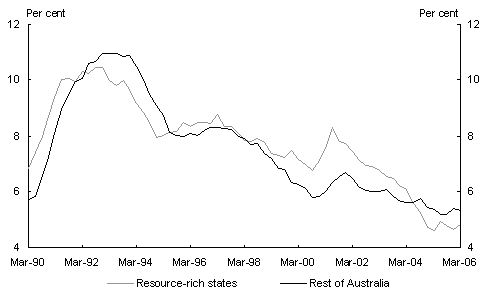
Chart 10: Participation rates
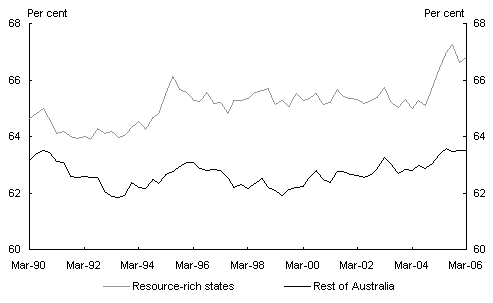
It is difficult to make an assessment of the full distributional implications of a sustained increase in the terms-of-trade. I have identified a number of important effects that derive from decisions made by private economic agents. But the actions of governments are important also; in particular, the way in which the government recycles higher income tax revenues, including through payments that assist the retraining of labour and structural adjustment. On that matter, it is worth noting that there is a body of evidence confirming that structural adjustment support works best if it is targeted to the welfare of individuals rather than the protection of jobs or industries.12
Implications for industry policy
Assuming some of the increase in the terms-of-trade is long lasting, are there other implications for government policy? I’m going to come to macroeconomic policy in a moment; but what about industry policy? A lesson from Australia’s economic reform experience is the importance of securing efficient resource allocation through strong competition and price-guided markets. A key component of the reform effort was the progressive dismantling of industry plans and other forms of industry policy intervention. Yet, despite that record, and despite the fact that the Australian economy is now operating at close to full capacity, with relatively few idle resources, many people think that industry policy should be doing something in response to higher terms-of-trade. The first test that should be applied to any proposal in this area is the following: Does the proposal seek to resist the change in resource allocation implied by the higher terms-of-trade, or is it empathetic with that change? Proposals that resist the changes I have outlined here should themselves be resisted. My reasoning is straight-forward: Let’s just suppose for the moment that we wanted to prevent the consequences of an increase in the terms-of-trade to which I have referred. What would be the best policy means of achieving such an objective? The answer is an across-the-board additional tariff on all imports at a flat rate of about 25 per cent. Now that would be absurd. But the point is this: absurd as it is, anything else would be worse.
But what if the terms-of-trade boom turns out to be short-lived, while many businesses in the manufacturing sector have closed because of a universal expectation that
the resources boom will go on forever? Won’t we then have much to regret? Yes, we will. But if you think that has implications for industry policy, ask yourself why it should be easier to persuade government that the terms-of-trade boom is temporary than it is to persuade the manufacturing businesses that are contracting and their financiers who are withdrawing capital. I can accept that there may be a case for taking out some insurance against a retreat in the terms-of-trade — a point I have made already in relation to fiscal policy — but I fully expect, indeed, I know it to be true in many cases, that businesses and those who supply financial capital to them are doing the same thing.
If, however, the terms-of-trade improvement does turn out to be long-lived, then the best thing policy will have been able to do is to ensure that the reallocation of resources required to maximise national income at those terms-of-trade proceeds with minimal disruption. While the reallocation of resources has, to date, been generally smooth, thanks largely to past economic reforms — including in the labour market, isolated events of the last couple of years confirm that the future task will be smoother still if we can address some of the issues in pricing, competition and competitive neutrality, in transport, energy and water needed to ensure efficient infrastructure investment and service delivery.13 There may also be an important role for governments in human capital policies, especially education initiatives that reduce the degree of sectoral rigidity in labour markets. These observations underline both the significance of the ambitious COAG National Reform Agenda agreed in February of this year, and the vital importance of those reforms being implemented as expeditiously and as fully as possible.
Implications for the global economy
The adjustment to a sustained change in world relative prices driven by the emergence of China has many dimensions. I have spent some time exploring some of the possible implications of China’s emergence for domestic resource allocation and domestic policy. But if we take a global perspective, the most significant consequence of China’s emergence is surely in the massive social change that is taking place within the world’s most populous nation. We should not lose sight of the fact that these changes, despite their potential to disrupt, are bringing enormous benefits to hundreds of millions of people.
I noted earlier too that while we are enjoying a terms-of-trade improvement, some countries are having their terms-of-trade hammered by China’s emergence. These countries are worse off, even though the overall welfare of the world is improved. This goes some way to explaining the forces resisting globalisation. Yet, a retreat to protectionist policies in these countries would make them even worse off.
The future need not be that bleak. Many industrialising economies, including some in our geographic region, and a number of large industrialised economies with deteriorating terms-of-trade, will find manufacturing exports that are complementary, rather than competitive, with China’s production; things like manufacturing components. In other cases, economies will share in the rewards of China’s emergence through capital flows.14
Fiscal policy
I want to conclude my presentation with a few comments on fiscal policy.
I have noted that strong commodity prices have had an impact on the budget. Over the most recent three years, 2002-03 to 2004-05, underlying cash surpluses have averaged 1 per cent of GDP, per cent of GDP above the average over the previous five years. Moreover, the surplus is expected to be around 1percent of GDP in 2005-06 and remain above 1 per cent of GDP over the forward estimates, even with our projected decline in commodity prices.
Clearly fiscal policy is relatively tight — especially by international standards. Should it be tighter? Some think it should, because there is the potential for the terms-of-trade to fall sharply and for income growth to slow. As I have noted, we have already taken out some insurance for this eventuality through our projection assumptions. And while this insurance does not fully unwind the increase in commodity prices, it is substantial, with nominal GDP projected to grow at a rate a full percentage point below its longer term average.
But there are other metrics for ascertaining the suitability or otherwise of the stance of fiscal policy, and these relate to the behaviour of the real economy. Over the recent period, the real economy has been growing at around trend, with output close to full capacity. Furthermore, we have had no significant increase in inflation in this period— no rapid acceleration in prices — with little change in monetary policy settings. It is far from obvious that an alternative fiscal policy approach would have generated superior macroeconomic outcomes.
Some of the criticism of the fiscal strategy appears based on a couple of misconceptions. Let me quickly address those. Having a medium-term fiscal framework does not imply there will only be fiscal surpluses in the future even if the recent increase in commodity prices turns out to be persistent. Importantly, it also doesn’t imply that there can never be deficits. And it does not presage the death of discretionary fiscal policy, as has been suggested by some commentators.15
I have observed here that Australia is in an enviable position to benefit from the global structural change associated with China’s re-emergence. But China’s re-emergence does not imply stronger real GDP growth. Potential real GDP growth is driven by the ‘3Ps’ of ‘population’, ‘participation’ and ‘productivity’. It remains the case that our potential growth rate will be lower in the future because of the impact on ‘population’ and ‘participation’ of the demographic changes I have spoken about on several other occasions. The unemployment rate is already at the level projected for the next 40 years in the 2002-03 Intergenerational Report. And productivity growth appears currently to be back to the long run trend rate projected in that document.
Far from providing grounds for complacency, China’s re-emergence adds substantial weight to the case for implementing in full the Council of Australian Governments national reform package of productivity-enhancing structural reforms. While I have developed this argument on an assumption that the terms-of-trade stay well above historical average levels for a sustained period, the case is only stronger if the present commodity price boom turns out, after all, to be just another spike.
References
Australian Industry Group 2006, ‘Business prospects for Australian manufacturing in 2006’, February.
Blanchard, O 2005, ‘European unemployment: The evolution of facts and ideas’, NBER Working Paper 11750, November.
Garnaut, R 2005, ‘Is macroeconomics dead? Monetary and fiscal policy in historical context’, Oxford Review of Economic Policy, vol 21, no. 4, pp 1-8.
Gruen, D 2006, ‘A tale of two terms-of-trade booms’, Economic Roundup, Summer, pp1-10.
Henry, K 2005, ‘The task of economic policy’, Sydney Papers, vol 17 nos. 3/4, Winter/Spring.
Rybczynski, T 1955, ‘Factor endowments and relative commodity prices’, Economica, XXII, November, pp 336-41.
Samuelson, P 2004, ‘Where Ricardo and Mill rebut and confirm arguments of mainstream economists supporting globalisation’, Journal of Economic Perspectives, vol18, no. 3, Summer, pp 135-46.
Stolper, W and Samuelson, P 1941, ‘Protection and r
eal wages’, Review of Economic Studies, IX, November, pp 58-73.
The Treasury 2001, ‘Global poverty and inequality in the 20th century: turning the corner?’ Economic Roundup, Centenary Edition, pp 1-52.
1 I would, as usual, like to thank Treasury colleagues for assistance in the preparation of this speech, especially, on this occasion, David Gruen and Steven Kennedy.
2 See, for example, Treasury (2001).
3 Hong Kong, Korea, Singapore and Taiwan.
4 Indonesia, Malaysia, the Philippines and Thailand.
5 See, for example, Gruen (2006).
6 These are standard results from the Hechscher-Ohlin model of international trade.
7 Stolper and Samuelson (1941).
8 This is a consequence of production functions exhibiting constant returns to scale. It is a standard feature of Heckscher-Ohlin trade theory: provided there is not complete specialisation in the production of one of the products, there is a one-to-one correspondence between relative product prices and relative factor prices; in turn, there is a one-to-one correspondence between relative factor prices and the cost minimising capital-labour ratio used by each sector; in turn, there is a one-to-one correspondence between the capital-labour ratio used in each sector and the marginal (physical) product of each factor used in each sector; and marginal products equal real factor rewards. These various relationships are unaffected by changes in the total economy supplies of the factors of production. There is a financial market implication of the capital inflow: financial asset prices (for example., share prices) will be bid up, to the point where the expected rate of return on financial capital is equalised with ‘the world rate’, with due allowance for country and currency risk.
9 Rybczynski (1955).
10 See footnote 8.
11 Australian Industry Group (2006).
12 Blanchard (2005).
13 See Henry (2005) for more on reform issues in the transport, electricity and water sectors.
14 Samuelson (2004), points out that a productivity shock in one country – for example, associated with moving closer to the global production technology frontier – that improves productivity in an area in which other countries specialise, may lead to these countries’ welfare being lowered. This is because the terms of trade move against the countries in which there has not been a productivity shock, reducing the gains from trade. Of course, despite the terms of trade also moving against the country that experiences the productivity boost, it still benefits from the increase in productivity and is better off.
15 Garnaut (2005).